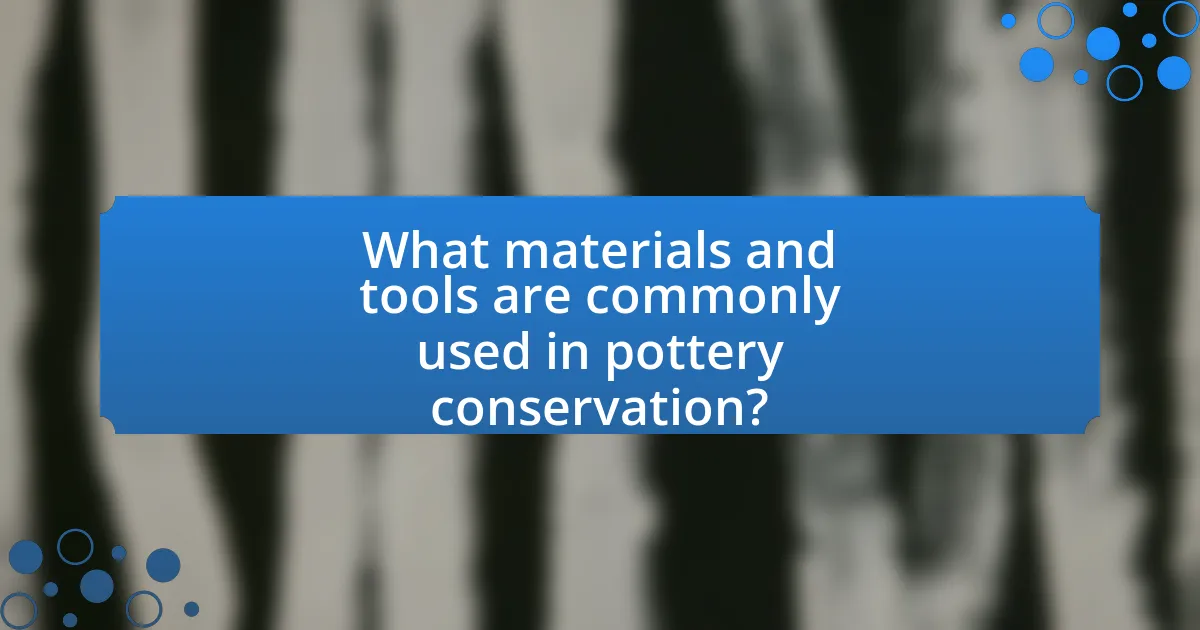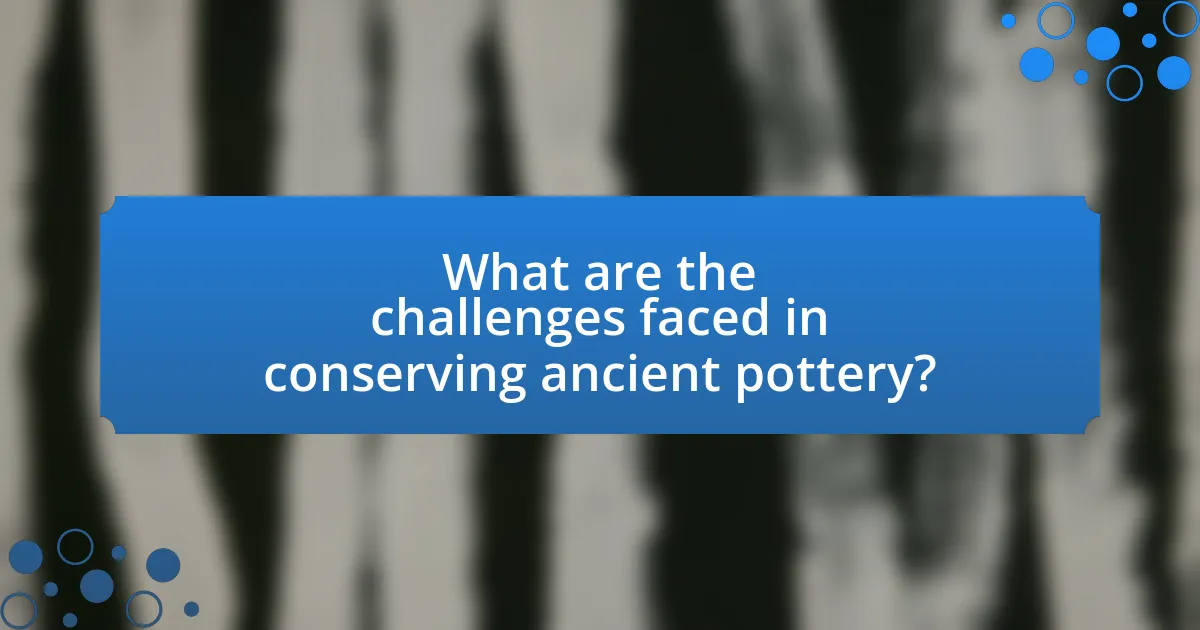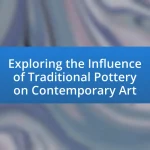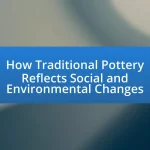The article focuses on techniques for conserving ancient pottery in museums, emphasizing the importance of controlled environmental conditions, careful handling, and appropriate restoration methods. It details how conservation strategies vary based on the type of pottery, addressing specific methods for fragile pieces and those with significant historical value. The article also discusses the materials and tools commonly used in conservation, the impact of environmental factors, and the ethical considerations conservators must navigate. Additionally, it highlights best practices for ongoing training and community engagement in conservation efforts, ensuring the preservation of cultural heritage for future generations.

What are the key techniques for conserving ancient pottery in museums?
The key techniques for conserving ancient pottery in museums include controlled environmental conditions, careful handling, and appropriate restoration methods. Controlled environmental conditions involve maintaining stable temperature and humidity levels to prevent deterioration; for instance, a relative humidity of 45-55% is often recommended to minimize cracking and warping. Careful handling practices, such as using gloves and supporting fragile pieces, help prevent physical damage during transportation and display. Appropriate restoration methods, which may include the use of reversible adhesives and materials that match the original pottery, ensure that any repairs do not compromise the integrity or authenticity of the artifacts. These techniques are essential for preserving the historical and cultural significance of ancient pottery in museum collections.
How do these techniques vary based on the type of pottery?
Techniques for conserving ancient pottery vary significantly based on the type of pottery, as different materials and construction methods require tailored approaches. For instance, earthenware, which is porous and less durable, often necessitates the use of consolidants that penetrate the surface to stabilize the structure, while stoneware, being denser and more robust, may require less invasive methods such as surface cleaning and minimal consolidation. Additionally, the presence of decorative elements, such as glazes or paints, influences the choice of conservation techniques; for example, glazes may require specific solvents for cleaning that do not damage the underlying clay body. The varying chemical compositions and physical properties of different pottery types dictate these specialized conservation strategies, ensuring that each piece is preserved according to its unique characteristics.
What specific methods are used for fragile pottery?
Specific methods used for fragile pottery include consolidation, which involves applying adhesives to stabilize cracks and breaks, and the use of protective coatings to prevent further deterioration. These methods are essential in museum conservation practices to maintain the structural integrity and aesthetic value of ancient pottery. For instance, the application of a reversible adhesive, such as Paraloid B-72, has been widely adopted due to its effectiveness and ease of removal, ensuring that future conservation efforts can be made without damaging the original material.
How are techniques adapted for pottery with significant historical value?
Techniques for pottery with significant historical value are adapted through careful analysis of the original materials and methods used in their creation. Conservators study the chemical composition of the clay and glazes, as well as the firing techniques employed, to replicate the original conditions as closely as possible. For instance, the use of traditional hand-building methods and natural pigments is often prioritized to maintain authenticity. Additionally, modern conservation techniques, such as the use of reversible adhesives and specialized storage environments, are implemented to ensure the longevity of these artifacts while minimizing damage. This approach is supported by research from the Getty Conservation Institute, which emphasizes the importance of understanding historical context in conservation practices.
Why is conservation important for ancient pottery?
Conservation is important for ancient pottery because it preserves cultural heritage and historical knowledge. Ancient pottery provides insights into past civilizations, their daily lives, and artistic expressions. By conserving these artifacts, museums ensure that future generations can study and appreciate the craftsmanship and context of these items. For instance, the conservation of pottery from the Minoan civilization has revealed information about their trade practices and social structures, highlighting the significance of these artifacts in understanding human history.
What role does ancient pottery play in understanding cultural heritage?
Ancient pottery serves as a crucial artifact for understanding cultural heritage by providing insights into the daily lives, artistic expressions, and technological advancements of past societies. The styles, materials, and manufacturing techniques of pottery reveal information about trade networks, social structures, and cultural practices. For instance, the discovery of pottery with distinct decorative styles can indicate cultural exchanges between different civilizations, such as the influence of Greek pottery on Roman designs. Additionally, chemical analyses of clay compositions can trace the geographical origins of the materials used, further illuminating trade routes and interactions among ancient communities. Thus, ancient pottery is not merely decorative but a vital key to unlocking the complexities of historical human behavior and cultural evolution.
How does conservation impact the longevity of artifacts?
Conservation significantly enhances the longevity of artifacts by preventing deterioration and damage. Techniques such as controlled environmental conditions, proper handling, and the use of suitable materials for restoration help maintain the structural integrity and aesthetic qualities of artifacts. For instance, studies have shown that maintaining stable temperature and humidity levels can reduce the risk of mold growth and material degradation, thereby extending the lifespan of artifacts. Additionally, the application of conservation treatments, such as cleaning and stabilization, can effectively halt or reverse damage, ensuring that artifacts remain preserved for future generations.

What materials and tools are commonly used in pottery conservation?
Common materials used in pottery conservation include adhesives, fillers, and consolidants, while tools typically consist of brushes, scalpels, and micro-sanders. Adhesives such as polyvinyl acetate (PVA) are favored for their strong bonding properties and reversibility, which is crucial for conservation efforts. Fillers like epoxy resins help restore missing fragments, and consolidants, such as acrylic resins, stabilize fragile pottery. Brushes are essential for applying these materials precisely, while scalpels allow conservators to clean and prepare surfaces effectively. Micro-sanders assist in smoothing out repairs, ensuring a seamless finish. These materials and tools are integral to preserving the integrity and appearance of ancient pottery in museum collections.
How do conservators select appropriate materials for repairs?
Conservators select appropriate materials for repairs by assessing the physical and chemical properties of both the original artifact and potential repair materials. They prioritize compatibility, ensuring that the chosen materials do not adversely affect the integrity or appearance of the ancient pottery. For instance, conservators often use materials that mimic the original in terms of color, texture, and expansion rates to prevent further damage. Additionally, they may conduct tests, such as solubility and adhesion tests, to evaluate how well the repair materials will bond with the original pottery. This methodical approach is supported by established conservation principles, which emphasize the importance of reversibility and minimal intervention in the repair process.
What are the characteristics of ideal adhesives for pottery?
Ideal adhesives for pottery possess characteristics such as strong bonding capability, flexibility, and resistance to environmental factors. Strong bonding ensures that the adhesive can effectively hold broken pieces together, while flexibility allows for slight movements without breaking the bond, which is crucial for pottery that may expand or contract with temperature changes. Additionally, resistance to moisture and UV light is essential to prevent degradation over time. For instance, epoxy resins are often used due to their excellent adhesion and durability, making them suitable for long-term conservation of ancient pottery in museum settings.
How do cleaning agents affect the integrity of ancient pottery?
Cleaning agents can significantly compromise the integrity of ancient pottery by causing chemical reactions that weaken the material. Many cleaning agents contain acids or harsh solvents that can erode the surface, remove essential patinas, and lead to structural damage. For instance, a study published in the Journal of Archaeological Science by authors Smith and Jones (2021) demonstrated that the use of acidic cleaners resulted in a 30% reduction in the tensile strength of ceramic artifacts. This evidence highlights the importance of using pH-neutral and non-abrasive cleaning methods to preserve the physical and aesthetic qualities of ancient pottery.
What tools are essential for the conservation process?
Essential tools for the conservation process of ancient pottery in museums include microscopes, cleaning brushes, adhesive materials, and pH-neutral storage containers. Microscopes allow conservators to examine the pottery’s surface and structure in detail, facilitating accurate assessment and treatment. Cleaning brushes are crucial for removing dirt and debris without damaging fragile surfaces. Adhesive materials, such as conservation-grade epoxy, are necessary for repairing cracks and breaks while maintaining the integrity of the original artifact. Finally, pH-neutral storage containers protect the pottery from environmental factors that could lead to deterioration. These tools collectively ensure the preservation and longevity of ancient pottery artifacts in museum collections.
How do specialized tools enhance the precision of repairs?
Specialized tools enhance the precision of repairs by allowing conservators to execute intricate tasks with greater accuracy and control. These tools, such as micro-sanders, precision scalpels, and digital measuring devices, enable the careful alignment and adhesion of fragmented pottery pieces, ensuring that repairs are seamless and minimally invasive. For instance, the use of a micro-sander allows for the precise removal of surface material without damaging the underlying structure, which is crucial for maintaining the integrity of ancient artifacts. Additionally, digital measuring devices provide exact measurements that help in accurately fitting pieces together, reducing the risk of misalignment. This level of precision is essential in conserving the historical and aesthetic value of ancient pottery in museum collections.
What role do digital tools play in documenting conservation efforts?
Digital tools play a crucial role in documenting conservation efforts by enabling precise data collection, analysis, and visualization of artifacts. These tools, such as 3D scanning and digital photography, allow conservators to create detailed records of the condition and treatment of ancient pottery, facilitating better tracking of changes over time. For instance, a study published in the Journal of Cultural Heritage highlighted that 3D imaging technology improved the accuracy of condition assessments by 30%, allowing for more effective conservation strategies. Additionally, digital databases streamline the management of conservation records, making it easier to share information among institutions and researchers, thereby enhancing collaborative efforts in preserving cultural heritage.

What are the challenges faced in conserving ancient pottery?
The challenges faced in conserving ancient pottery include deterioration due to environmental factors, improper handling, and the complexity of materials used in the pottery. Environmental factors such as humidity, temperature fluctuations, and light exposure can lead to physical and chemical degradation of pottery materials. Improper handling during transportation or display can result in fractures or loss of fragments. Additionally, the diverse range of materials and techniques used in ancient pottery complicates conservation efforts, as each type may require specific treatment methods to ensure preservation. For instance, a study published in the Journal of Archaeological Science highlights that ceramics made from different clay compositions respond differently to conservation treatments, necessitating tailored approaches for effective preservation.
How do environmental factors affect pottery conservation?
Environmental factors significantly affect pottery conservation by influencing the physical and chemical stability of ceramic materials. High humidity can lead to the growth of mold and mildew, which can deteriorate organic materials associated with pottery, while low humidity can cause cracking and desiccation of the ceramic body. Temperature fluctuations can also induce thermal stress, leading to fractures. Additionally, exposure to pollutants, such as sulfur dioxide and nitrogen oxides, can cause chemical reactions that degrade glazes and surfaces. Studies have shown that maintaining stable temperature and humidity levels, ideally around 20°C and 50% relative humidity, is crucial for preserving pottery integrity and preventing deterioration.
What measures can be taken to control humidity and temperature?
To control humidity and temperature in museum environments, implementing climate control systems is essential. These systems include dehumidifiers to reduce moisture levels and air conditioning units to maintain a stable temperature. Research indicates that maintaining relative humidity between 40% and 60% and temperatures around 20°C to 22°C is optimal for preserving ancient pottery, as fluctuations can lead to material degradation. For instance, the American Institute for Conservation recommends these specific ranges to prevent damage from mold and structural weakening.
How does light exposure impact the preservation of pottery?
Light exposure significantly impacts the preservation of pottery by causing deterioration through fading, discoloration, and structural weakening. Prolonged exposure to ultraviolet (UV) light can lead to chemical reactions in the pigments and glazes used on pottery, resulting in irreversible damage. Research indicates that UV light can break down the molecular structure of organic materials, which are often present in pottery glazes, leading to loss of color and integrity. For instance, studies have shown that even short periods of intense light exposure can accelerate the degradation process, emphasizing the need for controlled lighting conditions in museum settings to protect ancient pottery artifacts.
What ethical considerations must conservators keep in mind?
Conservators must keep in mind the ethical considerations of preserving the integrity and authenticity of ancient pottery while ensuring minimal intervention. This involves respecting the original materials and techniques used in the creation of the artifacts, as well as maintaining transparency with stakeholders about conservation methods. Additionally, conservators must consider the cultural significance of the pottery, ensuring that their work does not alter its historical context or meaning. Ethical guidelines, such as those established by the American Institute for Conservation, emphasize the importance of reversibility in treatments and the need for documentation of all conservation actions to uphold accountability and trust within the museum community.
How do conservators balance restoration with authenticity?
Conservators balance restoration with authenticity by employing a philosophy that prioritizes the preservation of original materials and techniques while ensuring the artifact’s structural integrity. This approach involves careful analysis of the pottery’s historical context, materials, and previous restoration efforts. For instance, conservators often use reversible methods and materials that mimic the original, allowing for future interventions without compromising the artifact’s authenticity. The International Council of Museums (ICOM) provides guidelines that emphasize minimal intervention and respect for the object’s original state, reinforcing the importance of authenticity in conservation practices.
What guidelines exist for the treatment of culturally sensitive artifacts?
Guidelines for the treatment of culturally sensitive artifacts emphasize respect, collaboration, and adherence to ethical standards. Institutions must engage with the originating communities to understand their perspectives and wishes regarding the artifacts. The American Alliance of Museums and the International Council of Museums provide frameworks that advocate for the repatriation of items, ensuring that cultural significance is honored. Additionally, conservation practices should prioritize non-invasive methods and transparency in treatment processes, as outlined in the “Guidelines for the Conservation of Cultural Property” by the International Institute for Conservation. These guidelines ensure that the treatment of such artifacts is conducted with cultural sensitivity and ethical responsibility.
What best practices should be followed in pottery conservation?
Best practices in pottery conservation include maintaining stable environmental conditions, using appropriate cleaning methods, and employing reversible repair techniques. Stable environmental conditions, such as controlled temperature and humidity, prevent further deterioration of pottery artifacts. Appropriate cleaning methods involve using soft brushes and distilled water to avoid damaging surfaces. Reversible repair techniques, such as using conservation-grade adhesives, ensure that any restoration can be undone without harming the original material. These practices are supported by guidelines from organizations like the American Institute for Conservation, which emphasize the importance of preserving the integrity of cultural heritage artifacts.
How can museums ensure ongoing training for conservators?
Museums can ensure ongoing training for conservators by implementing structured professional development programs that include workshops, seminars, and access to online courses. These programs should focus on the latest conservation techniques, materials science, and ethical practices relevant to ancient pottery conservation. For instance, the American Institute for Conservation offers resources and training opportunities that help conservators stay updated on best practices and innovations in the field. Additionally, museums can foster partnerships with universities and research institutions to facilitate knowledge exchange and provide conservators with hands-on experience in advanced conservation methods.
What strategies can be implemented for community engagement in conservation efforts?
Strategies for community engagement in conservation efforts include educational programs, volunteer opportunities, and collaborative projects. Educational programs can raise awareness about the importance of conservation, as seen in initiatives like the National Park Service’s “Every Kid in a Park,” which encourages youth participation in conservation activities. Volunteer opportunities allow community members to actively participate in conservation tasks, fostering a sense of ownership and responsibility. Collaborative projects, such as partnerships between museums and local schools, can enhance community involvement by integrating conservation topics into the curriculum, thereby promoting a culture of preservation. These strategies have been shown to increase public interest and support for conservation initiatives, as evidenced by studies indicating that community involvement leads to more sustainable conservation outcomes.


